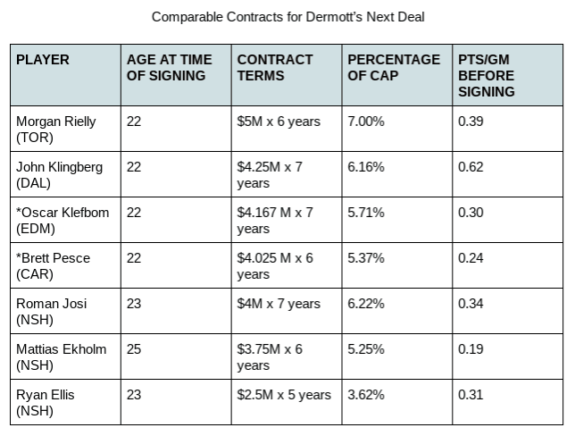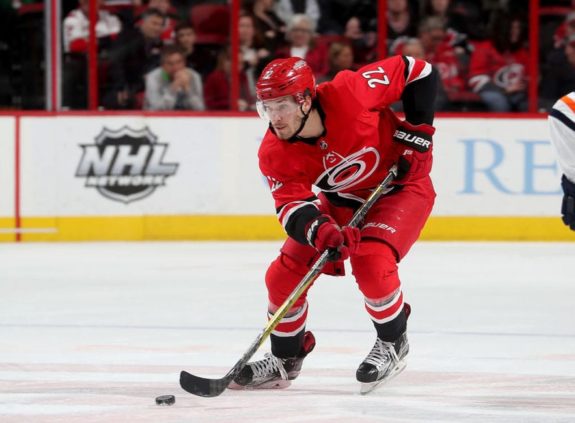The Toronto Maple Leafs are in a precarious salary cap situation, and as we’ve already seen, it’s taken several creative moves from general manager Kyle Dubas and his team to deal with those issues. But to prepare for the future and ensure that their cap can be managed moving forward, it will take foresight and proactivity.
One of the ways that Dubas can be proactive is by signing Travis Dermott to a contract extension as soon as possible – before his entry-level contract expires and before he further cements himself as an effective NHL defenceman.

The 22-year-old is coming off an impressive season in which he tallied 17 points in 64 games while adding three points in the playoffs. He underwent shoulder surgery in May and is expected to return around November. It may be the perfect time for the Maple Leafs to lock their young defenceman up before his value skyrockets.
Dermott Has Only Scratched the Surface
We’ve seen a season and a half of Dermott in the NHL, and it’s already clear that he’s going to be an excellent top-four defender – if he isn’t one already. Granted, Dermott has been deployed in relatively cushy bottom-pairing minutes, but he’s impressed in his role during his 21- and 22-year-old seasons.

Despite his relatively pedestrian point production thus far, Dermott has excelled in every other facet of the game. He’s a strong possession player, driving both shots and goals at both ends of the ice for the Maple Leafs. And it’s almost eery how similar he is, stylistically and statistically, to teammate Jake Muzzin.

Dermott is actually one of the best defenders of his own blue line in the entire NHL, ranking in the 99th percentile of entries allowed. His ability to exit the defensive zone with control (either by skating or passing the puck out) also can’t be understated.
While most young defencemen are still getting accustomed to the professional game, usually at the AHL level, Dermott has already won a Calder Cup with the Toronto Marlies and has become an important piece for the Maple Leafs. He’s one of their better defenders and hasn’t come close to tapping into his potential, especially on the offensive side. Dubas would be smart to lock Dermott up long term before he inevitably breaks out, emerges as a clear top-four defenceman, and demands a bigger payday.
Smart Teams Are Already Doing It
While young stars in the NHL are certainly being paid more than ever, we’re still seeing smart GMs locking up young players for long term on the cheap. And since players are often paid for their point production, it’s generally easier to keep defencemen to lesser cap hits.
The logic behind such a move is that you provide a young player with the stability of a long term deal at a reasonable cap hit before they’ve truly broken out. You’re essentially making a calculated bet that they will continue to develop and, usually within a season or two, outperform the value of the contract.
The most recent example of this would be Samuel Girard of the Colorado Avalanche who just signed a seven-year contract with an average annual value of $5 million. The 21-year-old defenceman notched 27 points this season and cemented himself as an excellent puck mover on Colorado’s back end, and GM Joe Sakic clearly saw enough in Girard to recognize his potential.

The real key here for Sakic was extending Girard a full year before his ELC expires. Girard has only played two seasons in the NHL, so he doesn’t have the most impressive track record yet. But Colorado is hedging their bets that he’ll continue to improve and with a consistently growing salary cap, his $5 million will look like a bargain in a few years.
We can look right under our noses for more examples, too. For all the bad contracts that Lou Lamoriello signed during his tenure in Toronto, the one thing he got right was extending young players to long-term deals that would clearly become bargains. Lamoriello signed both Morgan Rielly ($5M x 6) and Nazem Kadri ($4.5M x 5) to extensions before they truly broke out, opting for longer contracts over shorter bridge deals. Both players quickly outperformed their contracts and are now steals for their respective teams.

Dubas Can Learn from His Mistakes
Perhaps one of the biggest errors in Dubas’ tenure has been his unwillingness to extend his young stars before they break out. Last summer, Dubas had the opportunity to sign Auston Matthews and Mitch Marner to contract extensions a year before their ELCs expired. Matthews was coming off strong but injury-riddled season, while Marner had just scored 69 points – a far cry from his 94 points this past season. Whether it was the choice of Dubas or the players themselves, they weren’t able (or willing) to come to terms on extensions and we all know how that story played out.
Matthews improved, increased his production, and in February signed what could be called a record-setting deal that will pay him $11.634 million in each of the next five seasons. It seems like Matthews got the best of Dubas in both value and term, giving up only one year of unrestricted free agency. Would Dubas have been able to lock Matthews up at the same value with more term if he had acted sooner?

The Marner saga is still ongoing, but after his 94 point campaign, he’s clearly aiming to cash in. If Dubas had been more proactive last summer, could he have extended Marner for something like six years at $8 million per season? It seems likely. But now that he’s waited so long, he’s got to deal with a difficult negotiation that will strain both the salary cap and his relations with the player.

What Would Dermott’s Deal Look Like?
It’s clear that extending Dermott as soon as possible would be the prudent thing to do. But what exactly would such a deal look like?

Looking around the league, there are several comparable defencemen that signed long-term deals after their ELCs. Perhaps the most similar players to Dermott in terms of ability and production would be Ryan Ellis, Brett Pesce, and Oscar Klefbom. Each of these players showed flashes of high-end potential during their first two or three seasons but didn’t produce points at overly impressive rates (which obviously helped in keeping their salaries low).
At just 3.62 percent of the cap, Ellis looks like an outlier, so based on Klefbom and Pesce, it seems like Dermott could command around 5.5 percent of the cap on a six- or seven-year contract. That calculates to an AAV of $4.48 million based on the NHL’s salary cap of $81.5 million this year. Given that Dermott will be coming off multiple injuries sustained last season, perhaps he would take closer to $4 million in exchange for that long-term stability.

Regardless of the exact numbers, this is something that Dubas and the Maple Leafs need to prioritize right now. They’ve waited too long to sign their stars, and they’ve been burned. Dermott represents an opportunity to correct past mistakes, and to lock up a potential core piece for a long time.
Contract info from https://www.capfriendly.com/
Player stats from http://www.hockeydb.com/